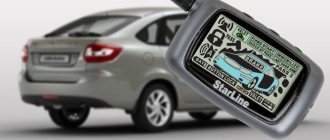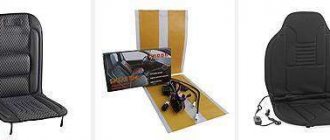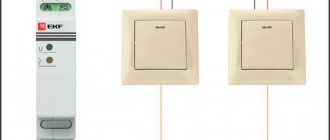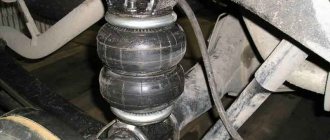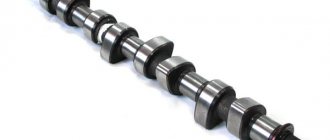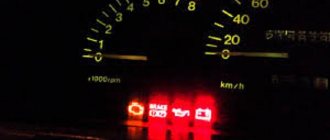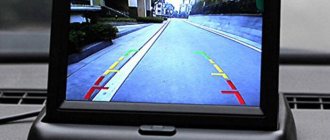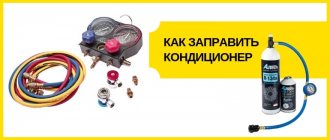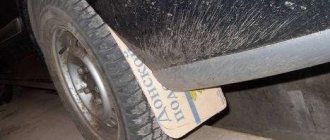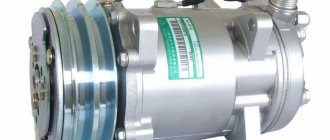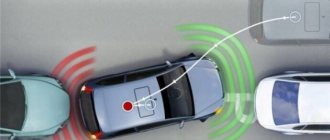Car air conditioners are refilled with freon or any other refrigerant as needed every 3-5 years. In a fully functional air conditioner, it is considered normal to leak up to 15% of the refrigerant per year, especially if the car is more than three years old. The fact is that the design of a car air conditioner contains many tubes, hoses, connections and rubber gaskets.
Under severe operating conditions (frost in winter, heat in summer, large temperature changes, constant vibration) such leaks occur.
In this article we will talk about how to refill a car air conditioner with freon, how much it costs, what equipment is available for refilling car air conditioners, and whether it is possible to refill them yourself. And at the bottom of the page, be sure to watch the video instructions for refueling car air conditioners with your own hands.
We also recommend our instructions for cleaning your car air conditioner.
We also note that refilling the air conditioner may also be required after repair or depressurization of the air conditioning system in the car.
Signs of recharging a car air conditioner
As a rule, at a service station, excess freon in a car air conditioner is determined by the excess pressure level in the system. If measurements were not taken after refueling, excessive refueling can be detected by the following external signs:
• the car air conditioner turns on and works, but its performance remains very low, and practically no cold air enters the cabin;
• the temperature at the compressor and condenser connection increases noticeably, which is detected when touched by hand;
• freezing of the evaporator and mains is observed;
• the air conditioner, after working for 10-15 minutes, turns off due to the activation of the pressure sensor.
How to refill a car air conditioner
Today, only 2 automobile freons are common, the third is not yet relevant:
- R12 . It boasts excellent cooling performance and low energy consumption. The catch lies in its composition. Namely, a certain percentage of chlorine, which negatively affects the environment. Studies have shown that long-term use of this refrigerant in car air conditioners has a negative impact on the state of the Earth's ozone layer. The so-called greenhouse activity (GWP) of these freons is very high;
- R134a . In terms of thermodynamic characteristics, it is close to 12th freon, but still 10-15% worse than it in terms of cooling capacity and is more fluid in the liquid state. However, it does not contain cotton. The GWP of the refrigerant is 1430. Today it is often used in refrigeration equipment. In automobile air conditioners, its use twenty years ago was difficult: serious technical adaptation of the main unit of the system, namely the compressor, was required;
- R1234yf . New generation of freons that meets the EG/706/2007 standard. They have a GWP of only 4. An environmentally friendly refrigerant gas, which unfortunately is flammable. Until 2021, car air conditioners were adapted to this refrigerant very rarely, but now, according to the decrees of a number of countries, it will be a priority. Since it is rarely used (and will be so for several more years), we only note that mixing it with one of the two above types of freons is prohibited.
So far, only the first 2 types of refrigerants are common. So, to summarize: mixing R12 with R134a (and vice versa) when topping up is strictly prohibited. Possible malfunctions: accelerated wear of parts, increased volume, change in cooling capacity.
What to do in case of excess freon?
If the above symptoms appear after refueling, it is necessary to remove excess freon from the system as soon as possible to avoid serious damage. Excessive pressure can lead to:
• failure of the compressor clutch or failure of the pressure plate;
• destruction of sealing rings and depressurization of the circuit;
Many car owners are interested in when to refill the air conditioning in their car? little freon left in the car’s cooling circuit , it’s time to refill the car’s air conditioner. To save extra money, you can do it yourself.
But how exactly do you refill the air conditioner yourself? What tools will be needed for this? And what rules should you remember? These issues will be discussed below.
What is crimping and how to do it?
But before refueling the system, it is necessary to check the strength of the pipelines; for this purpose, pressure testing is performed. This procedure is carried out using nitrogen, which is pumped into the system lines under high pressure. Thanks to this, you can verify the tightness of the pipes, as well as the quality of the connections. The pressure testing procedure involves the use of inert and safe nitrogen, to which a little freon is added.
The process itself consists of the following steps:
- If there is no freon in the system, as in your case, then nitrogen is immediately charged into it. If there is freon, it must be removed.
- Nitrogen is then removed from the pipes.
- The split system is being evacuated.
- Then the condenser is refilled with consumables, that is, freon.
It is advisable to entrust the crimping procedure to specialists who will do everything using a special stand.
Price issue
As for the cost, in this case it all depends on the car model. For example, the price for a Priorovsky Conder will be about 32 thousand rubles, while air conditioners for Lada Largus cost around 100 thousand. For Daewoo Nexia, the cost of purchasing a device varies around 30 thousand rubles, for Volkswagen Polo - about 39 thousand.
When to refill your car air conditioner
Every year, for natural reasons, the amount of freon in the cooling system decreases by 10-20%, so it is necessary to periodically refill the air conditioner. Please note that the power of the device drops significantly even if the freon loss is 50 percent or more.
It is recommended to refill your car's air conditioner at least every 3 years!
Do-it-yourself refueling of a car air conditioner is required in the following cases:
- Violation of the tightness of pipes;
- Mechanical damage to pipes;
- Condenser coated with rust.
Frequency of refueling
During the operation of the car air conditioner, a partial leak of refrigerant, that is, freon, gradually occurs. The generally accepted loss rate is no more than 15% during the year. It follows that you can refill the air conditioner in your car every 3 years of normal use. If leaks and depressurization occur during operation, then additional repairs and earlier refueling will be required.
But it is important to understand that old machines that have been in operation for a long time, due to natural aging processes, have more intense natural leakage, even if there are no breakdowns. In this case, refueling is carried out approximately once every 1 – 2 years. In this case, the filling method is similar.
If your car's air conditioner has damage, defects or breakdowns associated with intense refrigerant leakage, then there is no point in refilling it. First you need to find out what is wrong with freon and why it is being actively consumed. Having eliminated the problem, you can return to the usual periodic refueling of the unit.
There are two most common reasons:
- the tubes inside the system were damaged mechanically or due to the formation of corrosion processes, which led to loss of tightness;
- Corrosion began inside the capacitor, disrupting the integrity of the closed circuit.
It is not always possible to identify the damaged area on your own. Sometimes it is better to contact a service center, where ultraviolet light will be used to identify leaks. Having figured out how often you need to refill the air conditioner, you can move on to the issue of choosing a refrigerant.
Equipment and tools for refueling
To refill your car air conditioner with your own hands, you will need: a station for measuring pressure, an adapter with a tap, two hoses and a cylinder of freon.
From these components you need to assemble a device for refilling the air conditioning system.
The procedure should be as follows:
- Take a freon bottle and screw an adapter with a tap onto it (there should be a thread on the top of the bottle);
- Connect the hose to the adapter;
- Attach the hose to the pressure measuring station;
- Attach another hose with an adapter to the pressure control station on the other side;
- The filling device is ready. Please note that some stores sell already assembled devices.
Also, in some cases, you may need additional equipment - if you are doing evacuation, then you will need a vacuum pump , if you are checking the integrity of pipes with pressure, then in this case you will have to buy a cylinder with safe gas , and so on.
Freon selection
To charge the air conditioner, use R134a cooling mixture .
Older installations ran on R12 freon, but in the nineties this mixture was banned due to its negative impact on the environment, and after the ban, the R134a mixture began to be used in air conditioners. To refill a car air conditioner, about 700-1000 g of mixture is required.
Reference prices for diagnostics and refilling of car air conditioners
| Type of work | Cost, Russian rubles |
| Charging the system with refrigerant (evacuation, evacuation, leak test, refilling) | 1000 rub. (excluding refrigerant cost) |
| Refilling the car air conditioner | 600 rub. (excluding refrigerant cost) |
| Refrigerant R-134a | 150 rub. per 100 grams |
| Adding oil to the system | 300 rub. (including oil) |
| UV dye for oil (tracer) | 150 rub. |
| Diagnostics using a leak detector or ultraviolet | 500 rub. |
Once again, please note that prices are approximate and may differ from prices in your region.
Preparing for refueling
First of all, before refueling the air conditioner in the car with your own hands, you need to find and eliminate leaks, as well as perform vacuuming.
If the leaks are small, you can fix them yourself; for larger damages, we recommend contacting a car service center.
Finding and fixing leaks
If the freon in the air conditioner runs out due to damage to the pipes, then in this case you need to find and fix the leak. To find leaks, it is recommended to use a special tool called a leak detector . If there is no such device, then find the leak location as follows:
- Make a liquid mixture based on oil and freon;
- Add a special ultraviolet dye to the mixture;
- Refuel and turn on the air conditioner;
- After 5-10 minutes, take an ultraviolet lamp and shine it on the air conditioner - the damaged areas should turn greenish-yellow.
Which freon is better for car air conditioning
- EcoFrost (China);
- Refrigerant (China);
- XADO (Ukraine);
- Refco (China);
- Fotech International (China).
The best equipment for refilling freon today is provided by Italian companies: Werther, Spin.
You can buy freon in cylinders at a serious auto store. You can often find advertisements for sale online. It is worth remembering that the quality of automobile freons is approximately the same. This means that you don’t have to worry too much about the manufacturer – as long as the type of refrigerant is suitable for your vehicle.
In addition, experts recommend checking the condition of other elements of the car air conditioning system : dryer filter, cabin filter, sensors (in particular external and internal air), electric coupling. When choosing these parts, study the products of the following companies and give preference to them:
- Bosch (Germany);
- Blue Print (UK);
- Delphi (USA).
These companies supply relatively inexpensive analogues that are not inferior in quality to original spare parts.
Air conditioner refilling steps
Let's now find out how to refuel .
Please note that air conditioners differ very little from each other in their structure, so this scheme is suitable for all models:
- Locate the low pressure line (it looks like a small wide pipe with a narrower pipe underneath) and open the protective cap.
- Place the hose from the assembled filling device onto the nozzle.
- Start the engine (speed should be about 1,300-1,700 rpm). Please note that the engine must be turned on during the entire refueling procedure, so it is recommended to place a hard object under the gas pedal.
- Start air recirculation.
- Turn the freon bottle upside down. After this, gradually open the main tap and the freon valve (this must be done simultaneously). Freon pumping will begin.
- Watch the pressure gauge reading. The pressure level in the system should not exceed 275 kPa (otherwise you may damage the compressor).
- When the hose near the nozzle becomes very cold and cold air appears in the cabin (about 6-10 degrees), you need to gradually turn off the engine and remove the filling device. The refueling procedure is completed.
Procedure for filling car air conditioners with refrigerant
To refill car air conditioners on most modern cars, R-134a (tetrafluoroethane) refrigerant is used, but in the old fashioned way everyone calls it freon. To refill the air conditioning system of a small or medium-class passenger car, you will need an average of about 0.5 kg of refrigerant.
We recommend: The power steering is hard to turn - what's wrong?
You can find out information about the type of refrigerant for your car’s air conditioner and its refill rate from the service book for the car. Also, this information is often indicated on a plate located on the inside of the hood.
Refilling car air conditioners with refrigerant consists of the following steps:
- Pumping out remaining refrigerant from the air conditioning system. Modern stations for refilling car air conditioners automatically pump out old refrigerant to weigh it and remove waste oil from it.
- Evacuation of the system. This is a very important stage in recharging the car air conditioner. As a result of this operation, residual air and moisture are removed from the system. To achieve a vacuum of the required depth, it may take from 10 to 30 minutes (depending on the power and class of equipment); it is impossible to perform high-quality vacuuming in 1-2 minutes.
- The leak test allows you to detect any leaks present in the system. If the evacuation is poor (stage No. 2), the leak test may not show existing leaks, which will lead to further malfunctions of the car air conditioner.
- Refilling the oil. During the operation of the car air conditioner, the oil filled into the system (on average about 15 grams) serves to lubricate the compressor mechanisms. Quite often, the oil is filled with a dye (tracer) to make it easier to identify possible leaks in the future.
- Refrigerant loading. This is the final stage of refueling car air conditioners, which takes place quite quickly. As we already wrote above, on average, about 500 grams of refrigerant are needed to refill one air conditioner in a passenger car.
After completing all stages of refueling, you need to start the car engine, turn on the air conditioning (blowing at full power), increase the engine speed to 2500-3000 rpm, after which you need to carefully observe the operation of the system:
- The pressure in the low and high pressure ports should return to normal immediately after turning on the car air conditioning compressor. The low pressure gauge should show about 2 bar, and the high pressure gauge should show 15-18 bar.
- Check the temperature of the low pressure circuit tube by touch with your hand - it should be cold.
- Cold air should come out of the deflectors in the car's interior, and the air conditioning compressor should periodically turn off.
The presence of all these signs indicates that the air conditioner in the car has been charged successfully and the driver can enjoy its proper operation.
As you understand, it will be practically impossible to refill a car air conditioner with high quality without professional equipment. However, you can assemble a kit for refilling car air conditioners yourself from available and inexpensive components yourself. At the end of this article, watch a video on how to use this set.
And for a general idea of the cost of this type of service, below we present the order of prices for refilling car air conditioners in large cities of Russia (Moscow, St. Petersburg, Volgograd, Nizhny Novgorod, Krasnodar, etc.).
Air conditioner care
Now you know how to charge the air conditioner in a car with your own hands. In conclusion, let's talk about the rules of care :
- Wash the radiator at least once every 3 months, as dirt and dust constantly settle on it, which significantly reduces the efficiency of the device.
- In winter, you need to warm up the air conditioner at least once a month. To warm up, you need to drive the car into a warm place and turn on the cooling device for 15-30 minutes.
If leaks occur, contact a service center for repairs or repair the pipes yourself.
Watch the video yourself to see how to recharge the air conditioner in your car.
How the unit works
To understand how to refill a car air conditioner, you need to understand the operating principle of the equipment. This system consists of several components. Therefore, we can say that the air conditioner in a car consists of:
- compressor;
- capacitor;
- evaporator.
These are the key elements that play a major role in the operation of the equipment. From a practical point of view, the process of operating a car air conditioner is as follows:
- Freon, that is, a special composition in the form of a gas that provides cooling to the interior, circulates inside a closed circle and passes through all 3 elements of the system.
- The compressor is responsible for compressing the gas, which increases its temperature.
- After this, the refrigerant, which has become hot and is under high pressure, passes into the condenser. There it undergoes a cooling and condensation procedure, that is, it takes on a liquid form.
- Next, the freon follows the high-pressure circuit and approaches the expansion valve. Here the refrigerant is atomized and enters the evaporator.
- The evaporator is considered the key component, since this is where the cooling process begins. In the evaporator, freon evaporates, which allows heat to be removed from the air and the refrigerant to be cooled.
- Since freon is in a closed system, it again ends up inside the compressor (in the form of cold gas) on the low pressure side. Then the whole process is repeated again and again.
But you don’t have to be a certified expert in the design of automotive systems to figure out how to charge the air conditioner in a car.
What is vacuuming an air conditioner and how to do it?
Evacuation of an air conditioner is an important process that ensures trouble-free and long-lasting operation of the device. As you know, after installation is completed, the split system contains residual air and moisture that needs to be removed.
Preparing the split system for operation
During installation of the air conditioner, both blocks, external and internal, are connected to each other by two copper pipes, which form a system for circulating refrigerant in the refrigeration circuit of the system.
Upon completion of installation of the freon route, that is, pipes, there is air and residual moisture in the system. When freon interacts with the air in the pipes, it is formed, the influence of which has a detrimental effect on the operation of the equipment.
The long service life of the air conditioner depends on proper installation and evacuation of the route.
We recommend: Windshield washer pump - how it works
Carrying out commissioning works
To carry out quality work, you should stock up on special tools:
- Pump for air conditioners (vacuum).
- Station with hoses and pressure gauges.
- A refrigerant cylinder suitable for a split system.
- A set of keys and screwdrivers.
Having prepared all the necessary tools, let’s consider the process itself in more detail.
The first step is to connect the vacuum pump using the hoses of the manifold to the external tap of the air conditioner.
We turn on the pump to operate for 10-20 minutes, depending on the power of the connected device. During this time, the pump must pump out all remaining air and moisture from the inside and create a deep vacuum.
The evacuation process is monitored by taking readings from the pressure gauge. When the required indicator is reached in the system, the pump automatically turns off, and monitoring of the internal state of the system continues.
Causes of leaks:
- The nut is loose or too tight.
- One of the copper tubes is crooked.
- Low quality rolling.
Having made sure that a vacuum has been achieved, you can proceed to the next stage - introducing freon into the system. To start freon, you need to disconnect the pump and open the freon taps with a hex key. As a result of such actions, a hiss appears, indicating that the equipment is filled with freon circuit.
At the end of the process, the equipment can be considered completely ready for the first launch. During testing of equipment, all possible modes are subject to verification to ensure that their operation corresponds to the declared characteristics.
Connection diagram for vacuuming and refilling the air conditioner
Do-it-yourself vacuuming of equipment
In order to vacuum the air conditioner yourself, you need to disconnect one of the manifold hoses to choose from the filling valve, and the second using a vacuum pump for air conditioners. After completing the connections, start the pump and open the tap on the manifold. This way, the pump will remove all moisture, fine particles and air from the equipment.
After working for 20-30 minutes, turn off the system and watch the arrow, which is at 0 or 1. If the location of the arrow has not changed, then the system is completely sealed, otherwise you need to look for a breakdown.
It is very important to follow the basic rules for using an air conditioner.
To detect a breakdown in the system, first of all we check all connections using a soap solution. After checking and adjusting the system in the necessary places, repeat all the steps again. If a repeated operation leads to the same result, it is necessary to examine the rolling.
The most painful part of the device are the nuts (loose or severely torn off). In this case, it is necessary to do the reverse process - pumping freon into the air conditioner. To do this, connect the manifold to the valve and run the split system in the cold and close the tap on the thin pipe. As soon as a vacuum occurs, close the tap on the thick pipe.
At the end of the work, it is necessary to carry out all the steps again, starting with eliminating air and liquid in the system.
If you have achieved the tightness of the system, then the next stage of work will be to start the freon. To do this, unscrew 2 valves, thick and thin pipes, using a hex key. After disconnecting the collector, you can test the device and enjoy the result of your efforts.
As we can see, self-evacuating the air conditioner is a very real process for the common person.
What to watch out for
Many illiterate specialists, either due to lack of education or because of their own laziness, ignore evacuation of the split system, and instead expel part of the freon to displace the air. Such actions are strictly prohibited by the plant. Since they can lead to rapid breakdown and failure of an expensive system.
If your equipment is under warranty, then think carefully before getting into the system yourself. After outside intervention, service technicians decline all responsibility.
